Hazards of Radioactive Mineralization Associated with Pegmatites Used as Decorative and Building Material
Abstract
1. Introduction
2. Materials and Methods
2.1. Geological Setting
2.2. Radiometric and Mineral Analysis
3. Results and Discussion
3.1. Mineralogical Studies
3.1.1. Thorite ((Th, U) SiO4)
3.1.2. Phurcalite Ca2(UO2)3(PO4)2(OH)4·4H2O
3.1.3. Meta-Autunite (Ca(UO2)2(PO4)2·6H2O)
3.1.4. Kasolite Pb(UO2)SiO4·H2O
3.1.5. Xenotime (YPO4)
3.2. Radioactivity and Radiological Hazards Assessment
Radiological Hazards Parameters
4. Conclusions
Author Contributions
Funding
Institutional Review Board Statement
Informed Consent Statement
Data Availability Statement
Acknowledgments
Conflicts of Interest
References
- Akpanowo, M.A.; Umaru, I.; Iyakwari, S.; Joshua, E.O.; Yusuf, S.; Ekong, G.B. Determination of natural radioactivity levels and radiological hazards in environmental samples from artisanal mining sites of Anka, North-West Nigeria. Sci. Afr. 2020, 10, e00561. [Google Scholar] [CrossRef]
- Sivakumar, S.; Chandrasekaran, A.; Ravisankar, R.; Ravikumar, S.M.; Prince Prakash Jebakumar, J.; Vijayagopal, P.; Vijayalakshmi, I.; Jose, M.T. Measurement of natural radioactivity and evaluation of radiation hazards in coastal sediments of east coast of Tamilnadu using statistical approach. J. Taibah Univ. Sci. 2014, 8, 375–384. [Google Scholar] [CrossRef]
- UNSCEAR. Sources And Effects of Ionizing Radiation—Exposures of the Public And Workers From Various Sources of Radiation—UNSCEAR 2008 Report; UNSCEAR: Vienna, Austria, 2010; Volume I, ISBN 9789211422740. [Google Scholar]
- Pavlidou, S.; Koroneos, A.; Papastefanou, C. Natural radioactivity of granites used as building materials. J. Environ. Radioact. 2006, 89. [Google Scholar] [CrossRef] [PubMed]
- Khandaker, U.M.; Asaduzzaman, K.; Bin Sulaiman, A.F.; Bradley, D.A.; Isinkaya, M.O. Elevated concentrations of naturally occurring radionuclides in heavy mineral-rich beach sands of Langkawi Island, Malaysia. Mar. Pollut. Bull. 2018, 127, 654–663. [Google Scholar] [CrossRef]
- Boumala, D.; Mavon, C.; Belafrites, A.; Tedjani, A.; Groetz, J.E. Evaluation of radionuclide concentrations and external gamma radiation levels in phosphate ores and fertilizers commonly used in Algeria. J. Radioanal. Nucl. Chem. 2018, 317, 501–510. [Google Scholar] [CrossRef]
- Hassan, N.M.; Mansour, N.A.; Fayez-Hassan, M.; Sedqy, E. Assessment of natural radioactivity in fertilizers and phosphate ores in Egypt. J. Taibah Univ. Sci. 2016, 10, 296–306. [Google Scholar] [CrossRef]
- Calin, M.R.; Radulescu, I.; Calin, M.A. Measurement and evaluation of natural radioactivity in phosphogypsum in industrial areas from Romania. J. Radioanal. Nucl. Chem. 2015, 304, 1303–1312. [Google Scholar] [CrossRef]
- Hanfi, M.Y.M. Radiological assessment of gamma and radon dose rates at former uranium mining tunnels in Egypt. Environ. Earth Sci. 2019, 78, 113. [Google Scholar] [CrossRef]
- Ravisankar, R.; Chandrasekaran, A.; Vijayagopal, P.; Venkatraman, B.; Senthilkumar, G.; Eswaran, P.; Rajalakshmi, A. Natural radioactivity in soil samples of Yelagiri Hills, Tamil Nadu, India and the associated radiation hazards. Radiat. Phys. Chem. 2012, 81, 1789–1795. [Google Scholar] [CrossRef]
- Abbady, A.; Ahmed, N.K.; El-arabi, A.M.; Michel, R.; El-kamel, A.H.; Abbady, A.G.E. Estimation of radiation hazard indices from natural radioactivity of some rocks. Nucl. Sci. Tech. 2006, 17, 118–122. [Google Scholar] [CrossRef]
- ATSDR. Toxicological Profile for Uranium; Public Health Services Department of Health & Human Services: Washington, WA, USA, 1999; pp. 1–145.
- ATSDR. Draft Toxicological Profile for Radon: Agency for Toxic Substances and Disease Registry; Public Health Services Department of Health & Human Services: Washington, WA, USA, 2012; 9–11, pp. 161–167.
- La Verde, G.; Raulo, A.; D’Avino, V.; Roca, V.; Pugliese, M. Radioactivity content in natural stones used as building materials in Puglia region analysed by high resolution gamma-ray spectroscopy: Preliminary results. Constr. Build. Mater. 2020, 239, 117668. [Google Scholar] [CrossRef]
- Sahoo, B.K.; Nathwani, D.; Eappen, K.P.; Ramachandran, T.V.; Gaware, J.J.; Mayya, Y.S. Estimation of radon emanation factor in Indian building materials. Radiat. Meas. 2007, 42, 1422–1425. [Google Scholar] [CrossRef]
- Sabbarese, C.; Ambrosino, F.; Onofrio, A.D.; Roca, V. Radiological characterization of natural building materials from the Campania region (Southern Italy). Constr. Build. Mater. 2020, 121087. [Google Scholar] [CrossRef]
- Imani, M.; Adelikhah, M.; Shahrokhi, A.; Azimpour, G.; Yadollahi, A.; Kocsis, E.; Toth-Bodrogi, E.; Kovács, T. Natural radioactivity and radiological risks of common building materials used in Semnan Province dwellings, Iran. Environ. Sci. Pollut. Res. 2021, 28, 41492–41503. [Google Scholar] [CrossRef]
- Moghazi, A.M. Magma source and evolution of the late Proterozoic granitiods in the Gabal El-Urf area, Eastern Desert, Egypt: Geochemical and Sr-Nd isotopic constraints. Geol. Mag. 1999, 136, 285–300. [Google Scholar] [CrossRef]
- Abdel Ghani, I.M. Geology, Petrology, and Radioactivity of Gabal El-Urf Area, Central Eastern Desert. Ph.D. Thesis, South Valley University, Qena, Egypt, 2001. [Google Scholar]
- Asran, A.; El-Mansi, M.M.; Ibrahim, M.E.; Abdelghani, I. Pegmatites of gabal el urf, central eastern desert. In Proceedings of the 7th International Conference on the Geology of Africa, Assiut, Egypt, 24–26 November 2013. [Google Scholar]
- EL-Sherif, A.E. Mineralogical and Radioactive Characterization of Gabal El-Urf Pegmatites, Central Eastern Desert, Egypt. Al-Azhar Bull. Sci. 2015, 26, 85–96. [Google Scholar] [CrossRef][Green Version]
- Khalaf, E.A.; El-Azabi, M.; Mokhtar, H.; Bernard, K. Stratigraphy and facies architecture of the Neoproterozoic syn- and inter-eruptive succession: An example from Gabal El Urf, Northeastern Desert, Egypt. Precambrian Res. 2020, 350, 105905. [Google Scholar] [CrossRef]
- Eliwa, H.; Breitkreuz, C.; Khalaf, I.; Gameel, K. El Depositional styles of Early Ediacaran terrestrial volcanosedimentary succession in Gebel El Urf area, North Eastern Desert, Egypt. J. Afr. Earth Sci. 2010, 57, 328–344. [Google Scholar] [CrossRef]
- Matolin. Construction and Use of Spectrometric Calibration Pads Laboratory γ-Ray Spectrometry; NMA: New Cairo, Egypt, 1991. [Google Scholar]
- ICRP. 60 Recommendations of the International Commission on Radiological Protection; ICRP Publication 60; Pergamon Press Annals of the ICRP: Oxford, UK, 1990. [Google Scholar]
- Al-Hamarneh, I.F.; Awadallah, M.I. Soil radioactivity levels and radiation hazard assessment in the highlands of northern Jordan. Radiat. Meas. 2009, 44, 102–110. [Google Scholar] [CrossRef]
- Xinwei, L. Natural radioactivity in some building materials of Xi’an, China. Radiat. Meas. 2005, 40, 94–97. [Google Scholar] [CrossRef]
- Beretka, J.; Mathew, P.J. Natural radioactivity of australian building materials, industrial wastes and by-products. Health Phys. 1985, 48, 87–95. [Google Scholar] [CrossRef] [PubMed]
- Alam, M.N.; Chowdhury, M.I.; Kamal, M.; Ghose, S.; Islam, M.N.; Mustafa, M.N.; Miah, M.M.H.; Ansary, M.M. The 226Ra, 232Th and 40K activities in beach sand minerals and beach soils of Cox’s Bazar, Bangladesh. J. Environ. Radioact. 1999, 46, 243–250. [Google Scholar] [CrossRef]
- El Dabe, M.M.; Ismail, A.M.; Metwaly, M. Geology and Radioactivity of the Pegmatitic Rocks of Gabal El Urf, Northern Eastern Desert, Egypt. J. Rad. Nuci. Appl. 2022, 1, 1–13. [Google Scholar] [CrossRef]
- NEA-OECD. Exposure to Radiation from Natural Radioactivity in Building Materials; Report by NEA Group of Experts of the Nuclear Energy Agency; OECD: Paris, France, 1979. [Google Scholar]
- Abdel-Razek, Y.A.; Masoud, M.S.; Hanfi, M.Y.; El-Nagdy, M.S. Effective radiation doses from natural sources at Seila area South Eastern Desert, Egypt. J. Taibah Univ. Sci. 2016, 10, 271–280. [Google Scholar] [CrossRef]
- Harpy, N.M.; El Dabour, S.E.; Sallam, A.M.; Nada, A.A.; El Aassy, A.E.; El Feky, M.G. Radiometric and environmental impacts of mill tailings at experimental plant processing unit, Allouga, Egypt. Environ. Forensics 2020, 21, 11–20. [Google Scholar] [CrossRef]
- El Feky, M.G.; El Mowafy, A.A.; Abdel, A.W. Mineralogy, geochemistry, radioactivity and environmental impacts of Gabal Marwa granites, southeastern Sinai, Egypt. Chin. J. Geochem. 2011, 30, 175–186. [Google Scholar] [CrossRef]
- Baykara, O.; Karatepe, Ş.; Doǧru, M. Assessments of natural radioactivity and radiological hazards in construction materials used in Elazig, Turkey. Radiat. Meas. 2011, 46, 153–158. [Google Scholar] [CrossRef]
- UNSCEAR. Exposures from Natural Radiation Sources (Annex B). Sources and Effects of Ionizing Radiation; UNSCEAR: New York, NY, USA, 2000; pp. 84–141. [Google Scholar]
- USEPA EPA. Radiogenic Cancer Risk Models and Projections for the U.S. Population; EPA: Washington, DC, USA, 2011.
- Ravisankar, R.; Chandramohan, J.; Chandrasekaran, A.; Prakash, J.P.; Vijayalakshmi, I.; Vijayagopal, P.; Venkatraman, B. Assessments of radioactivity concentration of natural radionuclides and radiological hazard indices in sediment samples from the East coast of Tamilnadu, India with statistical approach. Mar. Pollut. Bull. 2015. [Google Scholar] [CrossRef]
- Gaafar, I.; Elbarbary, M.; Sayyed, M.I.; Sulieman, A.; Tamam, N.; Khandaker, M.U.; Bradley, D.A.; Hanfi, M.Y. Assessment of Radioactive Materials in Albite Granites from Abu Rusheid and Um Naggat, Central Eastern Desert, Egypt. Minerals 2022, 12, 120. [Google Scholar] [CrossRef]

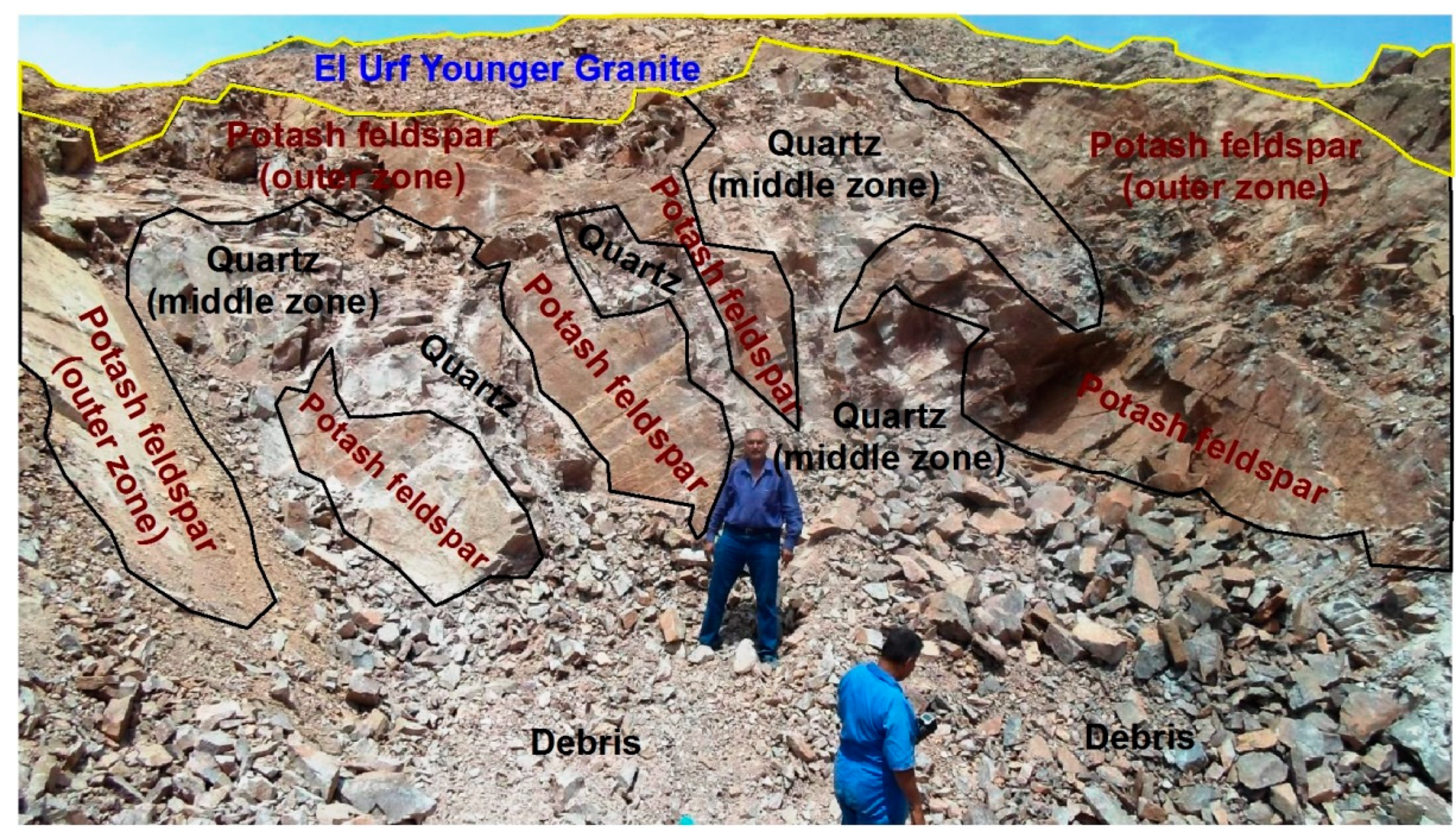
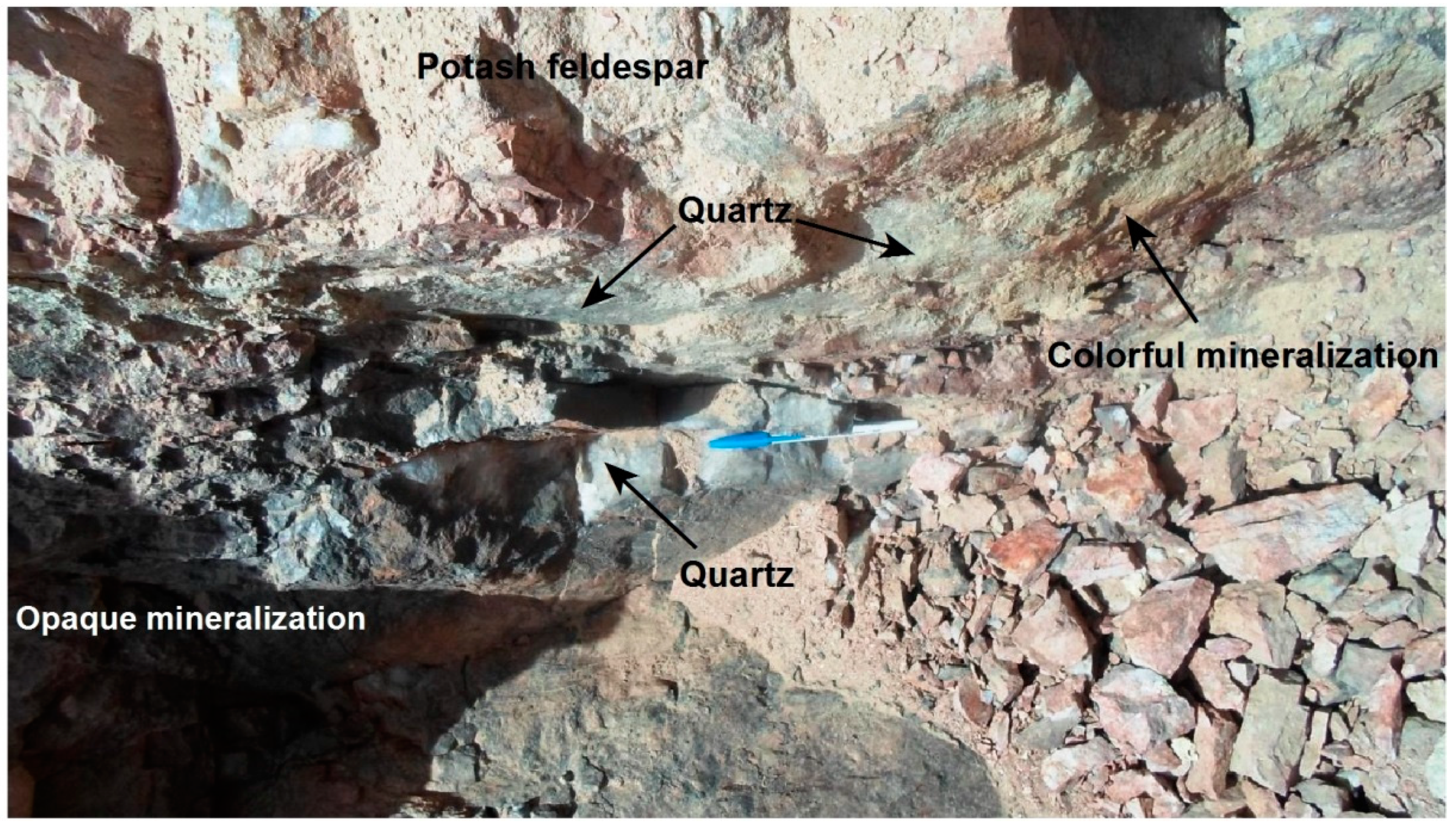


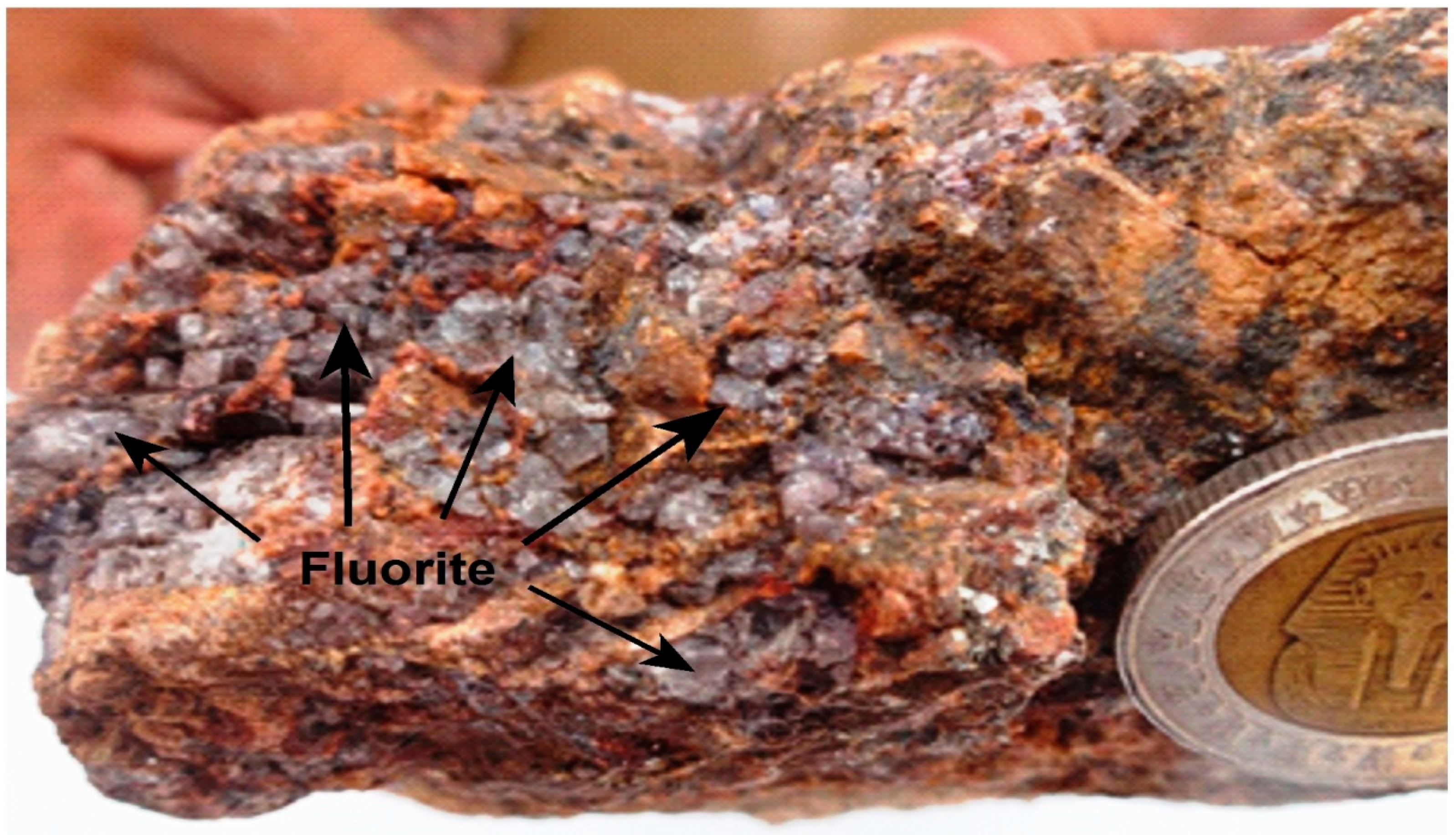
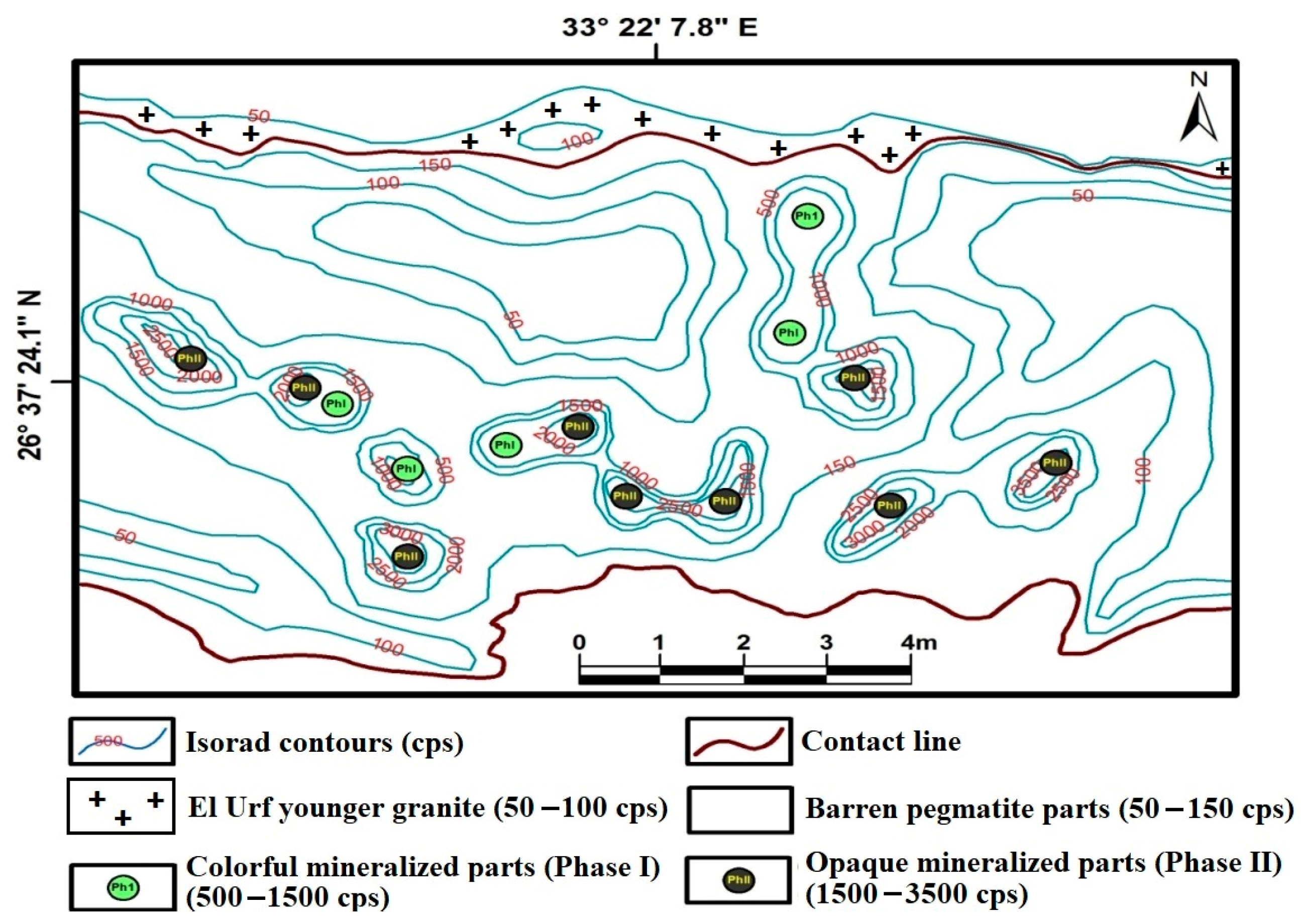

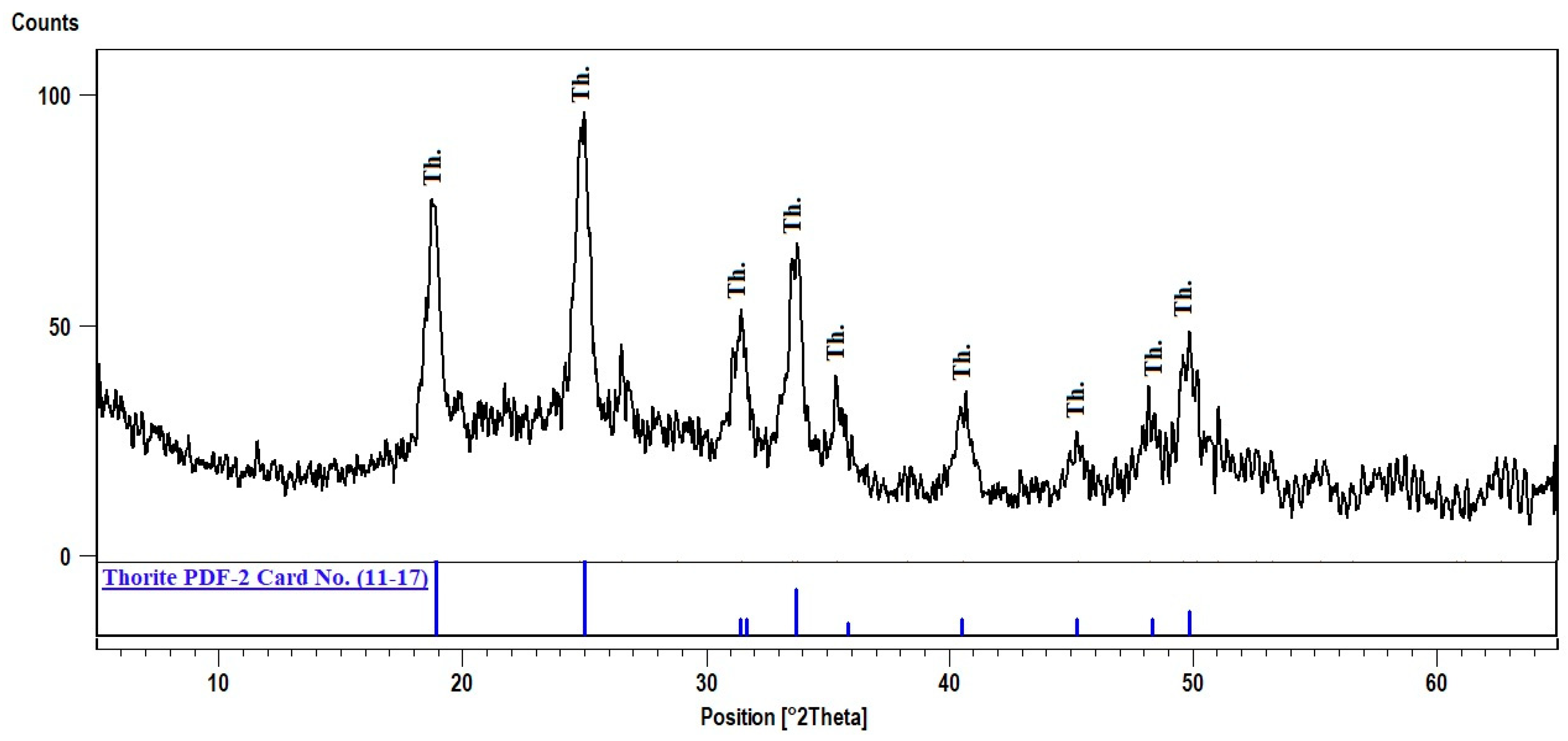

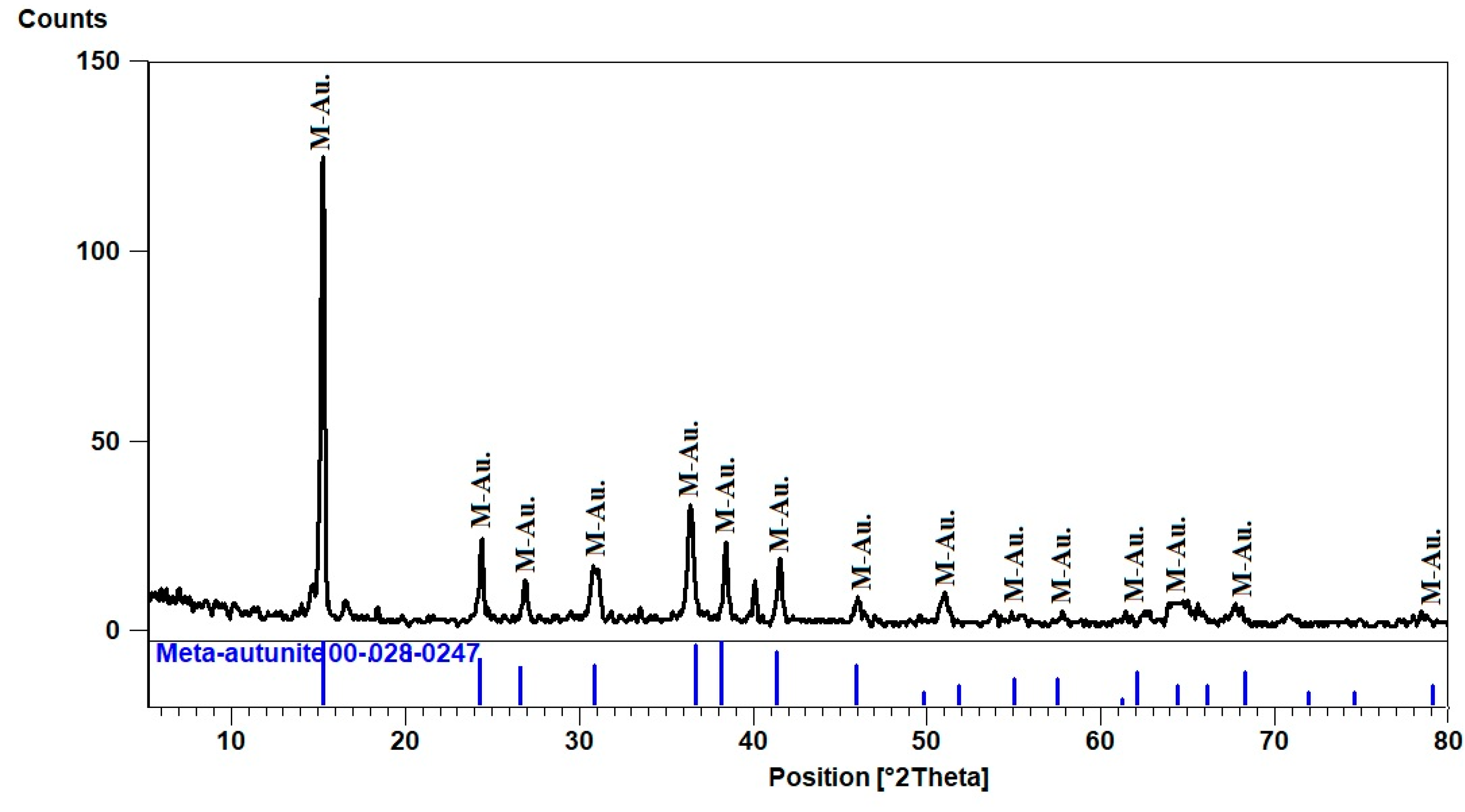
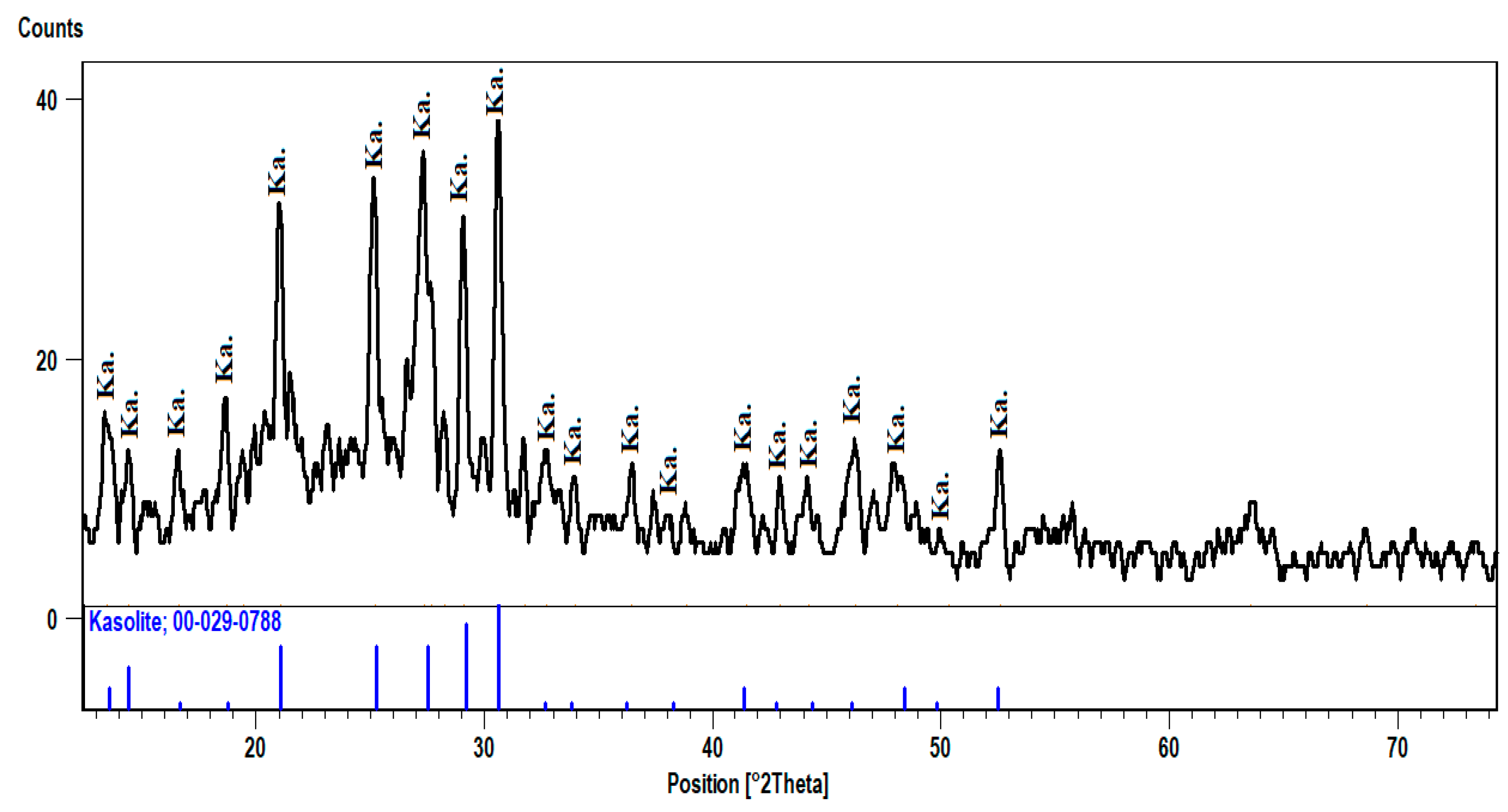

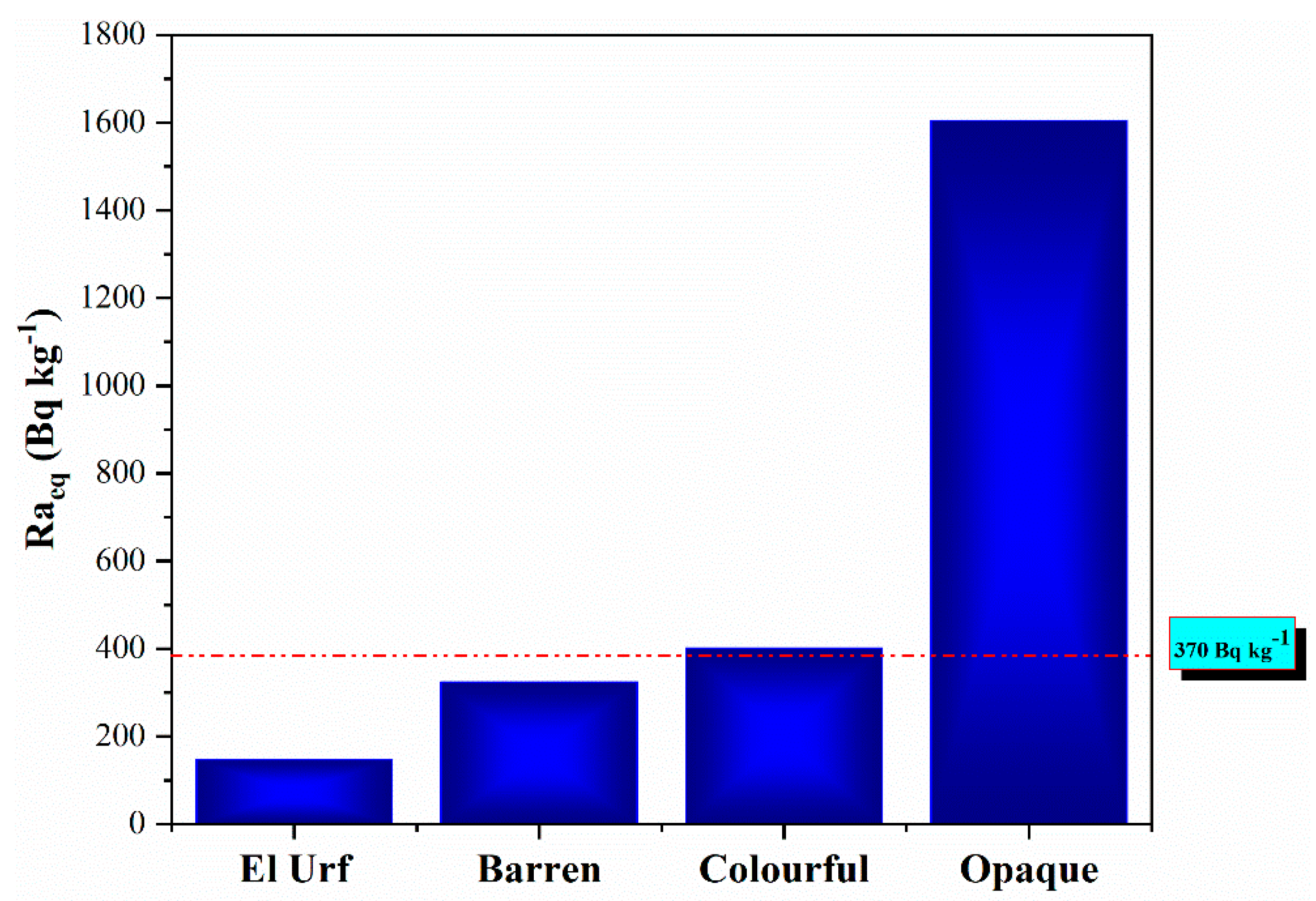
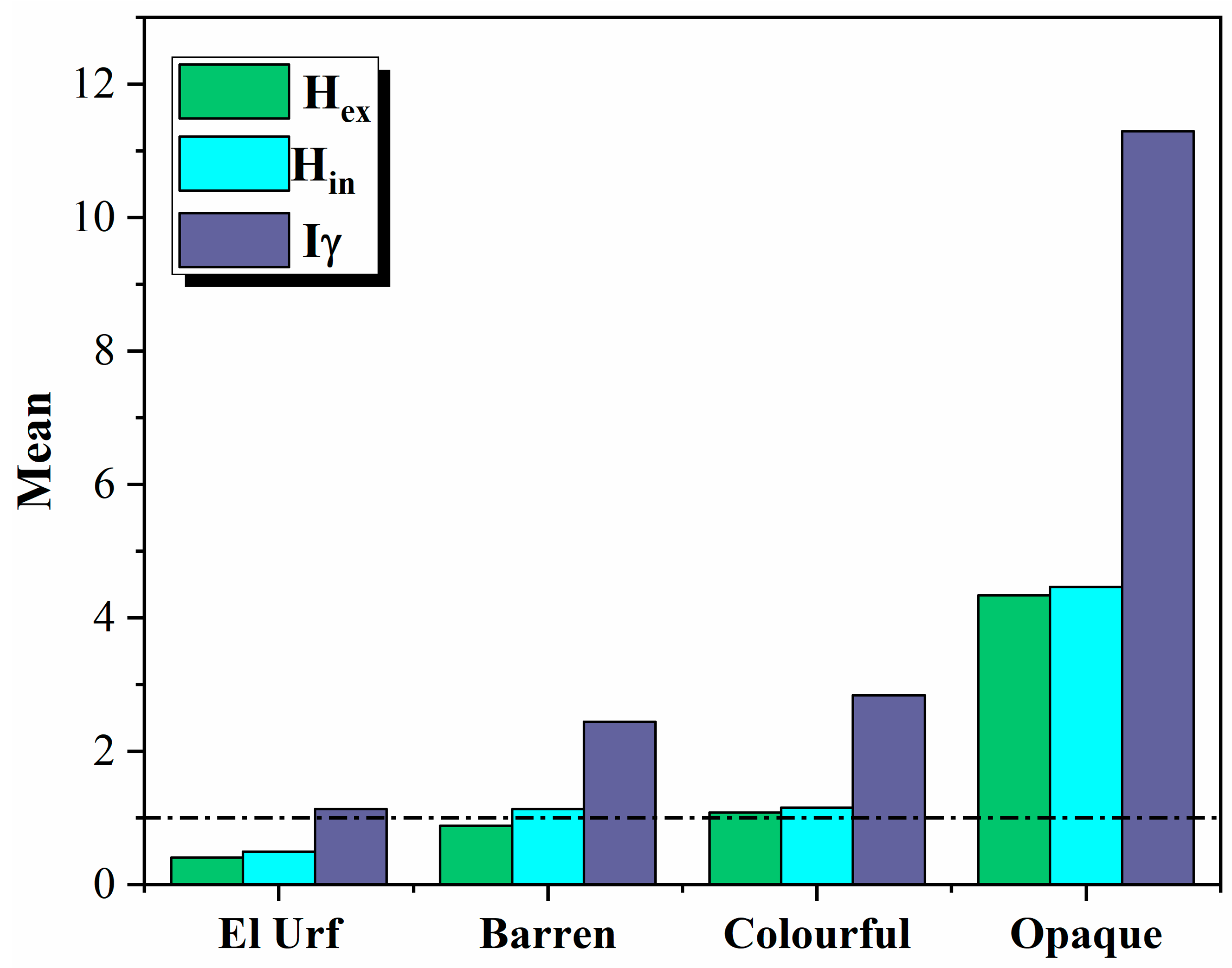
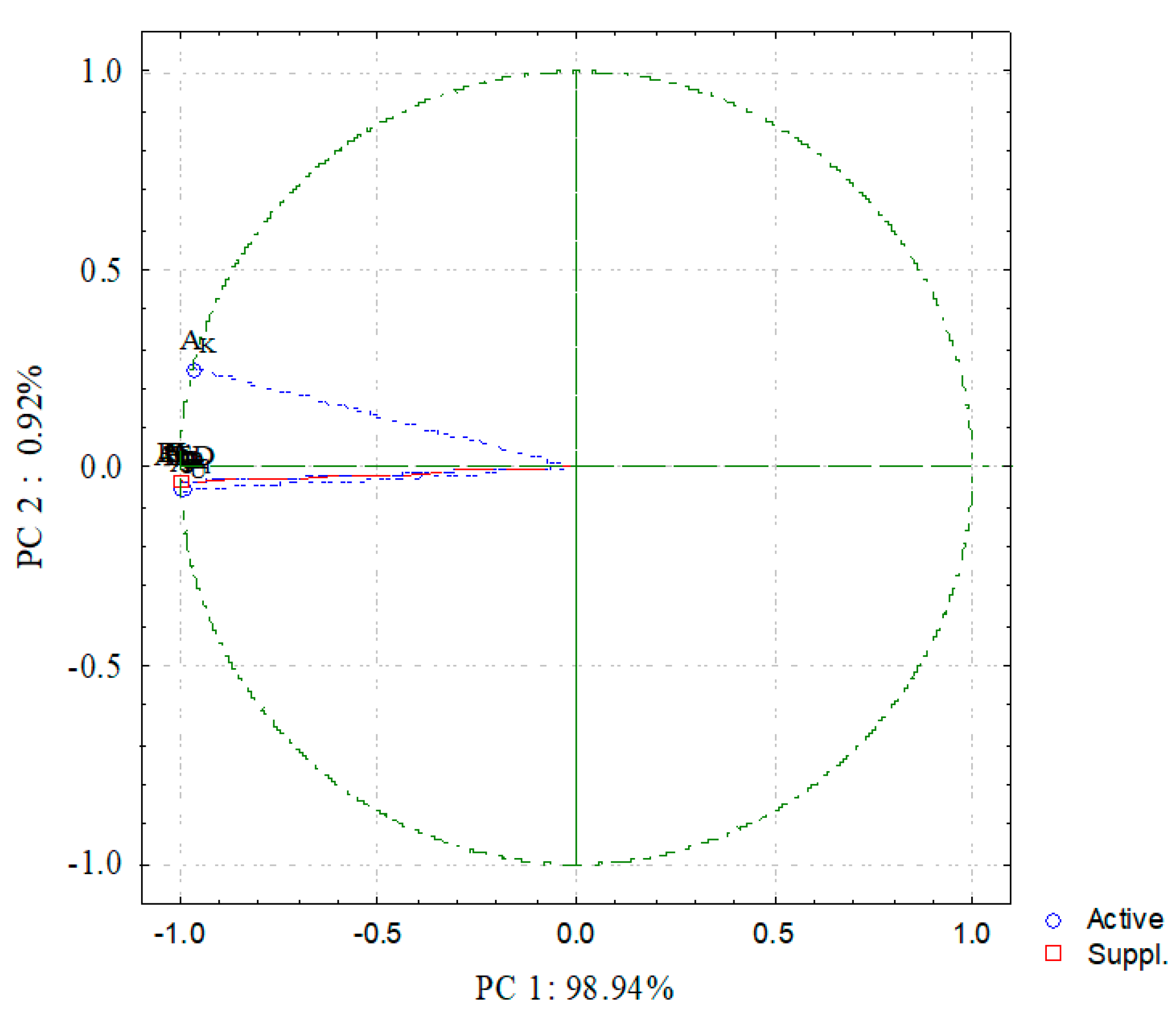

| Parameter | Symbol | Definition | Formula |
|---|---|---|---|
| Radium equivalent activity | Raeq | Radium equivalent activity is a weighted sum of the 226Ra, 232Th and 40K activities according to the hypothesis that 370 Bq kg−1 of 226Ra, 259 Bq/kg of 232Th and 4810 Bq/kg of 40K attain the same dose rates of gamma rays | Raeq (Bq kg−1) = ARa + 1.43 ATh + 0.077 AK |
| External hazard index | Hex | The external hazard index is the radiological parameters applied to assess the hazard of γ-radiation [25,26] | |
| Internal hazard index | Hin | The internal hazard index is applied to the internal exposure from radon and its decay products [27,28] | |
| Radiation level index | Iγ | The other index used to estimate the level of γ-radiation hazard associated with the natural radionuclides in the samples was suggested by a group of experts due to the different combinations of specific natural activities in the sample [29,30] | |
| Absorbed dose rate | D (nGy/h) | The absorbed dose rate is the radioactive factor that was applied to detect the effect of gamma radiation at 1 m from the radiation sources in the air due to the concentrations of 238U, 232Th and 40K | Dair (nGy h−1) = 0.430 AU + 0.666 ATh + 0.042 AK |
| Outdoor annual effective dose | AED | The annual effective dose is a radioactive factor utilized to detect the exposure level for radiation during a stationary duration (1 year) | AED (mSv y-1) = Dair (nGy/h) × 0.2 × 8760 (h/y) × 0.7 (Sv/Gy) × 10−6 (mSv/nGy) |
| Rock Type | Series of Observations No #. | AU | ATh | AK | Dair | AED | Raeq | Hex | Hin | Iγ |
|---|---|---|---|---|---|---|---|---|---|---|
| Bq kg−1 | Bq kg−1 | Bq kg−1 | (nGyh−1) | mSv | Bq kg−1 | |||||
| El Urf younger granite | 1 | 25 | 23 | 664 | 53.31 | 0.07 | 109 | 0.30 | 0.36 | 0.84 |
| 2 | 16 | 16 | 407 | 33.85 | 0.04 | 70 | 0.19 | 0.23 | 0.54 | |
| 3 | 42 | 37 | 1099 | 87.65 | 0.11 | 180 | 0.49 | 0.6 | 1.38 | |
| 4 | 40 | 28 | 898 | 72.63 | 0.09 | 149 | 0.4 | 0.51 | 1.14 | |
| 5 | 46 | 45 | 1202 | 98.79 | 0.12 | 203 | 0.55 | 0.67 | 1.56 | |
| Av | 34 | 30 | 914 | 71.75 | 0.09 | 147 | 0.4 | 0.49 | 1.13 | |
| SD | 11 | 10 | 291 | 23 | 0.03 | 48 | 0.13 | 0.16 | 0.37 | |
| min | 16 | 16 | 407 | 33.85 | 0.04 | 70 | 0.19 | 0.23 | 0.54 | |
| max | 46 | 45 | 1202 | 98.79 | 0.12 | 203 | 0.55 | 0.67 | 1.56 | |
| Barren pegmatite parts | 6 | 64 | 71 | 1083 | 117.75 | 0.14 | 249 | 0.67 | 0.85 | 1.86 |
| 7 | 87 | 82 | 1474 | 151.26 | 0.19 | 318 | 0.86 | 1.09 | 2.38 | |
| 8 | 92 | 86 | 1552 | 158.85 | 0.19 | 333 | 0.9 | 1.15 | 2.5 | |
| 9 | 119 | 69 | 2009 | 180.23 | 0.22 | 372 | 1 | 1.33 | 2.82 | |
| 10 | 84 | 74 | 1424 | 142.87 | 0.18 | 299 | 0.81 | 1.04 | 2.25 | |
| 11 | 79 | 84 | 1340 | 142.97 | 0.18 | 302 | 0.82 | 1.03 | 2.26 | |
| 12 | 123 | 69 | 2075 | 184.98 | 0.23 | 381 | 1.03 | 1.36 | 2.89 | |
| 13 | 96 | 89 | 1621 | 165.46 | 0.2 | 347 | 0.94 | 1.2 | 2.61 | |
| 14 | 121 | 75 | 2050 | 186.85 | 0.23 | 386 | 1.04 | 1.37 | 2.93 | |
| 15 | 85 | 74 | 1434 | 143.95 | 0.18 | 301 | 0.81 | 1.04 | 2.27 | |
| 16 | 75 | 77 | 1277 | 134.29 | 0.16 | 283 | 0.76 | 0.97 | 2.12 | |
| 17 | 87 | 82 | 1474 | 150.95 | 0.19 | 317 | 0.86 | 1.09 | 2.38 | |
| Av | 93 | 78 | 1568 | 155.01 | 0.19 | 324 | 0.88 | 1.13 | 2.44 | |
| SD | 18 | 6 | 305 | 20 | 0.03 | 40 | 0.11 | 0.16 | 0.31 | |
| min | 64 | 69 | 1083 | 117.75 | 0.14 | 249 | 0.67 | 0.85 | 1.86 | |
| max | 123 | 89 | 2075 | 186.85 | 0.23 | 386 | 1.04 | 1.37 | 2.93 | |
| Colorful Mineralized parts (phase-I) | 18 | 267 | 743 | 1969 | 132.22 | 0.16 | 305 | 0.82 | 0.88 | 2.16 |
| 19 | 208 | 566 | 1562 | 101.01 | 0.12 | 233 | 0.63 | 0.67 | 1.65 | |
| 20 | 403 | 1327 | 2980 | 230.17 | 0.28 | 533 | 1.44 | 1.53 | 3.77 | |
| 21 | 282 | 791 | 2100 | 140.57 | 0.17 | 324 | 0.88 | 0.94 | 2.3 | |
| 22 | 500 | 1854 | 3449 | 316.7 | 0.39 | 734 | 1.99 | 2.09 | 5.19 | |
| 23 | 301 | 851 | 2225 | 151.01 | 0.19 | 348 | 0.94 | 1.01 | 2.47 | |
| 24 | 288 | 809 | 2197 | 143.66 | 0.18 | 331 | 0.9 | 0.96 | 2.35 | |
| Av | 321 | 992 | 2354 | 173.62 | 0.21 | 401 | 1.08 | 1.15 | 2.84 | |
| SD | 91 | 413 | 594 | 69 | 0.09 | 160 | 0.43 | 0.45 | 1.13 | |
| min | 208 | 566 | 1562 | 101.01 | 0.12 | 233 | 0.63 | 0.67 | 1.65 | |
| max | 500 | 1854 | 3449 | 316.7 | 0.39 | 734 | 1.99 | 2.09 | 5.19 | |
| Opaque Mineralized parts (phase-II) | 25 | 365 | 2866 | 2194 | 457.27 | 0.56 | 1071 | 2.89 | 2.97 | 7.53 |
| 26 | 700 | 5315 | 3409 | 849.92 | 1.04 | 1990 | 5.38 | 5.53 | 14 | |
| 27 | 508 | 3650 | 2936 | 585.77 | 0.72 | 1371 | 3.7 | 3.82 | 9.65 | |
| 28 | 444 | 3366 | 2570 | 538.35 | 0.66 | 1260 | 3.41 | 3.5 | 8.87 | |
| 29 | 365 | 2799 | 2132 | 447.29 | 0.55 | 1047 | 2.83 | 2.91 | 7.37 | |
| 30 | 565 | 4291 | 3271 | 686.2 | 0.84 | 1607 | 4.34 | 4.47 | 11.3 | |
| 31 | 683 | 5187 | 3446 | 829.35 | 1.02 | 1942 | 5.25 | 5.4 | 13.66 | |
| 32 | 544 | 4150 | 3155 | 663.33 | 0.81 | 1553 | 4.2 | 4.32 | 10.93 | |
| 33 | 764 | 5398 | 3506 | 867.37 | 1.06 | 2029 | 5.48 | 5.65 | 14.28 | |
| 34 | 612 | 4767 | 3205 | 760.95 | 0.93 | 1782 | 4.82 | 4.95 | 12.54 | |
| 35 | 365 | 2821 | 2113 | 450.51 | 0.55 | 1055 | 2.85 | 2.93 | 7.42 | |
| 36 | 569 | 4750 | 3296 | 755.14 | 0.93 | 1769 | 4.78 | 4.91 | 12.44 | |
| 37 | 754 | 5733 | 3440 | 916.67 | 1.12 | 2146 | 5.8 | 5.96 | 15.1 | |
| 38 | 631 | 4954 | 3393 | 790.43 | 0.97 | 1851 | 5 | 5.14 | 13.02 | |
| Av | 561 | 4289 | 3002 | 685.54 | 0.84 | 1605.05 | 4.34 | 4.46 | 11.29 | |
| SD | 127 | 891 | 446 | 143 | 0.18 | 335 | 0.90 | 0.93 | 2.36 | |
| min | 365 | 2799 | 2113 | 447.29 | 0.55 | 1047 | 2.83 | 2.91 | 7.37 | |
| max | 764 | 5733 | 3506 | 916.67 | 1.12 | 2146 | 5.8 | 5.96 | 15.1 |
Publisher’s Note: MDPI stays neutral with regard to jurisdictional claims in published maps and institutional affiliations. |
© 2022 by the authors. Licensee MDPI, Basel, Switzerland. This article is an open access article distributed under the terms and conditions of the Creative Commons Attribution (CC BY) license (https://creativecommons.org/licenses/by/4.0/).
Share and Cite
El Dabe, M.M.; Ismail, A.M.; Metwaly, M.; Taalab, S.A.; Hanfi, M.Y.; Ene, A. Hazards of Radioactive Mineralization Associated with Pegmatites Used as Decorative and Building Material. Materials 2022, 15, 1224. https://doi.org/10.3390/ma15031224
El Dabe MM, Ismail AM, Metwaly M, Taalab SA, Hanfi MY, Ene A. Hazards of Radioactive Mineralization Associated with Pegmatites Used as Decorative and Building Material. Materials. 2022; 15(3):1224. https://doi.org/10.3390/ma15031224
Chicago/Turabian StyleEl Dabe, Mohamed M., A. M. Ismail, Mohamed Metwaly, Sherif A. Taalab, Mohamed Y. Hanfi, and Antoaneta Ene. 2022. "Hazards of Radioactive Mineralization Associated with Pegmatites Used as Decorative and Building Material" Materials 15, no. 3: 1224. https://doi.org/10.3390/ma15031224
APA StyleEl Dabe, M. M., Ismail, A. M., Metwaly, M., Taalab, S. A., Hanfi, M. Y., & Ene, A. (2022). Hazards of Radioactive Mineralization Associated with Pegmatites Used as Decorative and Building Material. Materials, 15(3), 1224. https://doi.org/10.3390/ma15031224









